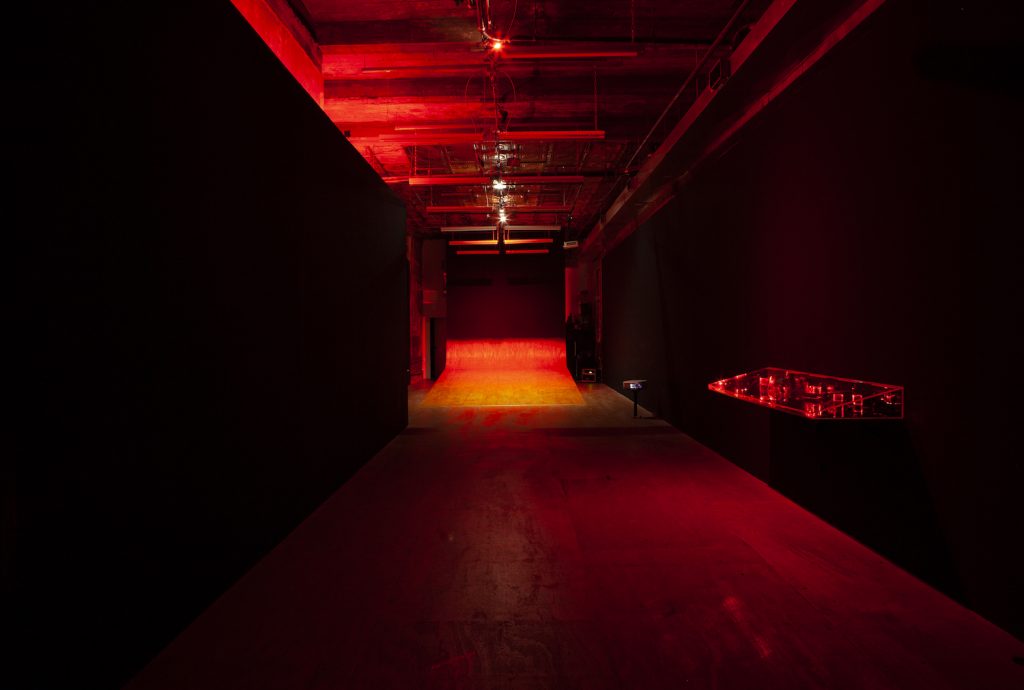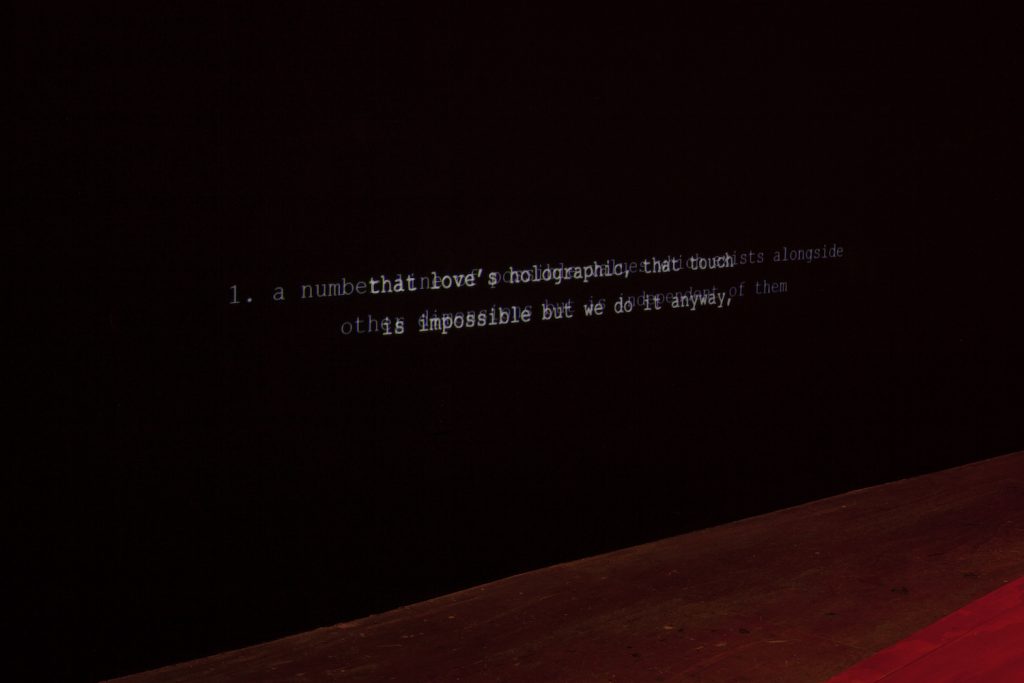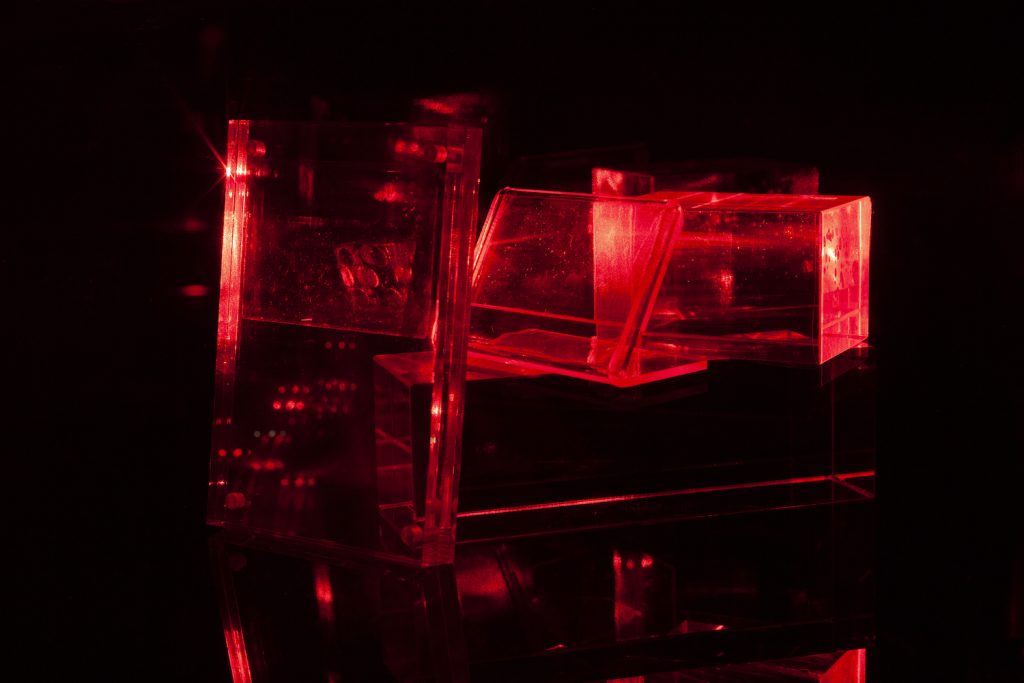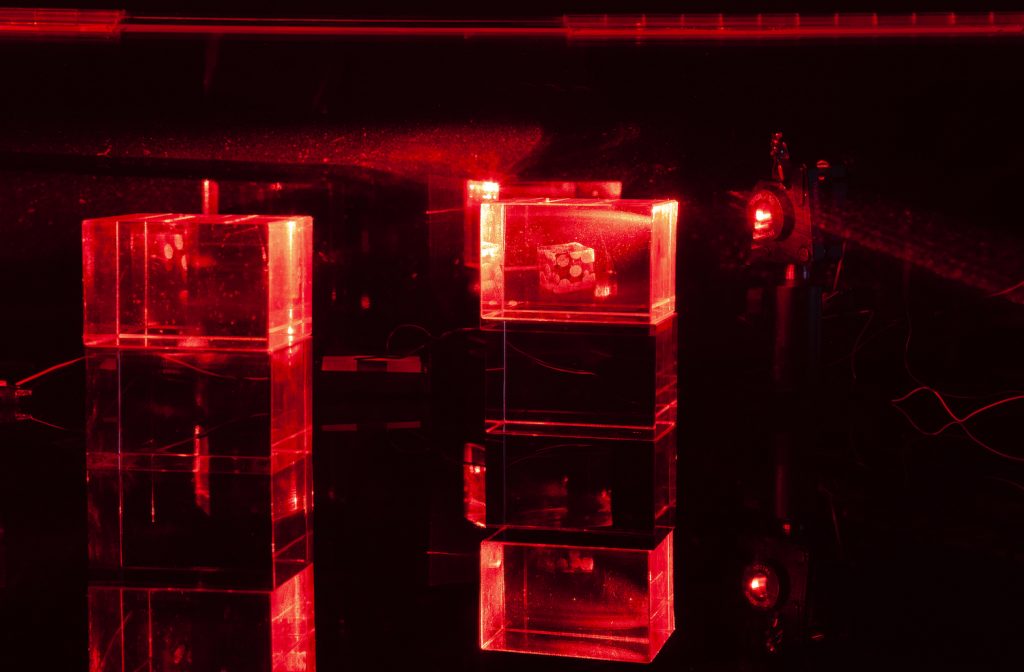Multi-Sensory “L&D Motel” at Participant INC
Holograms, an infrasonic install, permeating light and projected text fill this former sex club

L&D Motel by Constantina Zavitsanos, organized by Alex Fleming and Andrew Kachel at Participant INC, is the artist’s first-ever solo show in NYC. The new works presented by the artist combine and play with our reception of senses. Zavitsanos also reference’s the gallery’s past. When entering into the blackened space of the gallery, visitors are illuminated by red light—calling to attention the venue’s former existence as a sex club.

The exhibition revolves around three pieces: “Boxed Bet,” “Call to Post” and “All the time.” Centered on a ramp, “Call to Post” extends from the gallery’s floor to the ceiling. The installation is more than visual, visitors can stand or sit on the ramp, while sound plays through custom subwoofers. The sound is projected at five hertz (15Hz below the range in which humans can hear) which results in the viewer feeling it, rather than hearing it.

For “All the time” (a series of projected texts layered on top of one another while a recording of the artist’s voice plays) Zavitsanos uses light and sound as a primary material. The words can only be read when a shadow from the viewer obstructs one of the overlapping projections, while the voice can only be heard when the viewers are silent. Placed right next to “Call to Post,” this piece is disrupted often as people move on the ramp.

The red light filling the gallery comes from “Boxed Bet,” which is a series of transmission holograms of dice captured mid-toss, lit in part by red lasers that bounce off mirrors. The laser light concentrates the first visible frequency of light on the spectrum, and the lowest color frequency humans can see: red. This work plays with the idea of sight and image as a seemingly definite thing. When a transmission hologram is cut in half the image is not split, it doubles creating two intact images. Zavitsanos has much to say about the exhibition and the entities within.

Can you talk more about your “All the time” piece? Can you explain your process in using light as a material?
The large majority of the sound-waves in “Call to Post” are infrasonic, but for those parts that are at or above 20Hz, I captioned my voice. The text projections in “All the time” are those captions. Just as the ramp is two channels that often overlap and interfere with one another infra/sonically, the captions are two channels that overlap and interfere with one another visually. At most times, one voice or text is dominant and covers the other less legible one. While captioning has for some time aimed for clarity and legibility of content above affect or feel and material concept—this piece challenged me to do both and favor neither.

It’s a piece that’s both accessible and inaccessible to everyone—it doesn’t segregate audiences in terms of dis/ability. You can think the captions as a material emulation of what they transcribe. In one way they are exactly what’s there and in another, they are not at all what is there. But they are how what’s there is there. Two sonic voiced texts are overlapped, oscillating and coming in and out of phase or phrase in the ramp—and two texts are overlapped, occluded and revealed in the captions. The ramp is comprised of two channels of sound waves or vibrations reverberating the materials of the wooden structure; the caption’s two channels of projected light. Just as the ramp sounds or actually feels different with more or less viewer engagement, so too the captions change with viewer interaction. When someone blocks the first projector, the second projector reveals more legible text in their cast shadow. Shadows in the visible light spectrum are kinda everything, but that’s a whole other story I guess.

Did you imagine how “Call to Post” would be used other than being a work of art? It functions as a gathering place at the same time.
I wanted it to be a space that many people could inhabit in various ways simultaneously for sure… And the piece was literally made by feel and it’s intended to be used, touched, felt. Several friends came through during the process of making the sound on the ramp so that vibe was already there—there’s a soft insistence or tender encouragement to lay around and feel things through, specifically with others.
Today a person came through wanting to skate on it too—and I obliged. But the reason I made it a ramp was primarily for people using wheelchairs and walkers and whatnot to be able to access it and use it as desired. I straight up fantasized it. But, of course, I had no idea it’d turn out quite like this.

Were the gallery windows blacked out so that the holograms project outward, onto the people looking at them?
I blacked out the windows primarily because the holograms are best seen that way, but also the film is a 90% tint so some light comes through from the street in the day, and in the night when the lights are on inside the opposite occurs where the light inside shines out. The construction in front of the gallery already gives this feeling of closure and pushing that a bit more by blacking out the windows I thought may be intriguing. A lot of the show sonically and visually has to do with occlusion so it seemed only right to start with the doors.

How did you settle on the dice as your subject for “Boxed Bet” (2019)?
I mean, truthfully—I’m still unsettled on and by the dice. [This excerpt from Stéphane Mallarmé’s poem Throw of the Dice provided some inspiration:]
“in these latitudes
of indeterminate
waves
in which all reality dissolves”
Open through 20 October L&D Motel coincides with new work from the artist being presented at EFA Projects in their group exhibition Soft and Wet, open through 16 November.
Images courtesy of Constantina Zavitsanos












